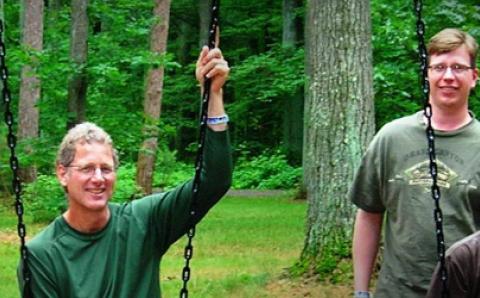In a recent survey, 70 percent of the Christian Reformed Church in North America’s 1,052 official congregations reported their ethnic make-up as primarily Anglo. Only 8 percent described their congregations as multiethnic. Yet the latter come closest to the vision of God’s church set before us in Revelation 7:
After this I looked and there before me was a great multitude that no one could count, from every nation, tribe, people, and language standing before the throne and in front of the Lamb. . . .
“We have been given the vision of Revelation 7 to aspire to. Our preparation should not be predicated on current church leadership or group percentages, but on obedience to God’s Word,” notes Rev. Esteban Lugo, director of Race Relations for the CRC since 2004. In addition, he points out that every church should be making efforts to become multiethnic because that is the future of the communities around us—if it isn’t already the case now.
Rev. Esteban Lugo: “We have been given the vision of Revelation 7 to aspire to.”
“As Reformed Christians, we have to believe that these demographic changes are a part of God’s overall plan,” Lugo said.
Lugo doesn’t think the CRC is doing all that well in becoming more ethnically diverse. “When I review the Yearbook statistics, it does not appear to be all that favorable,” he said. “From a denominational perspective, the results would show an increase over the past 20 years, but I think this has tapered off in the last five to six years or at least remained steady.”
What will it take to change? Lugo would like to see more ethnic minority leaders selected to plant churches among ethnic minority people. And he would like to see more resources applied to the development of multiethnic leaders, including scholarships for those leaders to attend Calvin Theological Seminary.
Sociologist George Yancey, keynote speaker for the CRC’s 2011 Multiethnic Conference, writes that becoming successfully multiethnic will be about survival and church growth. After receiving a Lilly grant to study successful multiethnic churches, Yancey wrote One Body, One Spirit: Principles of Multiracial Churches. In that book he observes that as our children and grandchildren increasingly experience ethnic integration in housing, education, and employment during the week, they will be less likely to accept a monocultural worship setting on Sundays.
Yancey lays out several principles he sees as necessary for successful multiethnic churches:
- Inclusive worship – worship that includes cultural elements of more than one ethnic group.
- Diverse leadership – leadership that reflects the racial diversity of church members.
- Intentionality – not just “allowing” a multiethnic atmosphere to develop, but taking deliberate steps to foster one.
- Personal skills – the abilities of a church leader to handle the needs and conflicts that arise when transitioning into a multiethnic environment.
- Location – multiracial churches tend to be grouped together in transitional areas of cities where whites move out and ethnic minorities move in.
- Adaptability – a readiness to adapt to new ethnic groups and cultures the church will encounter and to learn how to blend those cultures.
On this page you will find profiles of five Christian Reformed churches that have achieved some success in becoming multiethnic. They demonstrate that while such change is never easy, it’s a worthwhile adventure.
—Gayla R. Postma
Two Churches That Would Not Give Up
Grandville Avenue Christian Reformed Church and Bethel CRC, both started by Dutch immigrants in southwest Grand Rapids, Mich., in the late 19th century, faced a choice when the demographics of their community shifted from 99 percent white to largely Hispanic and African American in the 1970s and ’80s. Even though the white members who’d left the neighborhood commuted back for Sunday services, it was obvious that death throes gripped the congregations.
So in a bold move, the churches decided to abolish both congregations, blend, and re-emerge as Roosevelt Park Community CRC, specifically to serve the altered neighborhood.
“We wanted to be intentional in welcoming and inclusive without being condescending or paternalistic,” said Rev. Reginald Smith. “The first thing [we] did was hire leaders who are not white. I was the first hire as pastor almost 17 years ago. People come when the leadership looks like them.”
Rev. Reginald Smith: “People come when the leadership looks like them.”
Former World Missions church planter Rev. Pablo Canche followed in 2004. About 22 percent of the congregation reflects the multiethnic neighborhood.
Worship changed from stately hymns and psalms to livelier music. Not all of the members liked this and other changes.
“We took about 10 years to get to our present worship state,” Smith said. “I expect to be surprised every Sunday. I’ve experienced the gifts of songs, prayers, worship, and fellowship that show the Revelation vision of the church. We sing in English and Spanish. Christian hip-hop dancers bring an offering of praise to God. A Hispanic family gave testimonies in Spanish, while Pastor Pablo translated for them.”
While many former members left, 16-year member Jack Sluiter, 64, an elder, stayed. “My wife and I felt it was the right thing to do,” he said.
Attitudes were challenged, said elder Kelvin Jackson, 45, an African American who has attended Roosevelt Park for 14 years. “One of the most important changes is the language. It used to be ‘us and them’ or ‘those people.’ That’s a hurtful phrase if you’re on the outside.”
Jackson believes God called him to be a bridge-builder. “It’s not always comfortable. We’re learning to trust each other,” he said.
Smith said the makeover proved challenging. “We fought without giving up our principles to be biblical and theologically Reformed. We knew we would lose people on the edges, but we held to maintaining our commitment to reimage ourselves as God’s diverse people to glorify the triune God.”
In door-to-door interviews, members found that their neighbors wanted English classes, to be self-sufficient, and for youths to be mentored into leadership. Roosevelt Park Ministries became the medium of delivery. The church also joined neighborhood organizations to foster home ownership and to form a library and arts center.
“Evangelism is a core value. Both churches died as a result of not intentionally trying to reach the new community. We will not take for granted that we can sit on our laurels and minister only to ourselves,” Smith said. “We still need to intentionally evangelize our neighborhood. It’s hard because the results are few.
“Our churches have not done evangelism well, especially in urban areas, because our history has been to build churches for churched people. Our cities are now more brown and diverse, and our churches are caught in the thick of it,” he said.
Rev. Smith advises other churches to be unrelenting: “Ask hard questions that push a church to die and rise and live an adventurous life with the untamed Jesus.”
—Carolyn Koster Yost
Spirit & Truth Fellowship: Where Diversity Is a Value
The praise service begins even as the praise team starts to assemble: songs are sung in English and Spanish, and the pace picks up and the singing becomes more spirited.
The deacons—one African American, one Anglo, and one Hispanic—take up the offering.
Rev. Manny Ortiz preaches from Philippians on the transforming power of the gospel in difficult times. The services concludes with an invitation to come forward and pray. An Anglo woman kneels in front. An African American woman puts her arm around her, and together they pray.
Members of Spirit and Truth Fellowship enjoy a picnic.
This was a typical service on a nondescript corner of a lower socioeconomic neighborhood in north Philadelphia, Pa., where Spirit & Truth Fellowship Christian Reformed Church meets.
From its beginning in 1995, this church was intentionally multiethnic in a neighborhood that is approximately 55 percent Hispanic, 35 percent African American, and the remaining 10 percent Asian and Anglo.
Today both the membership and leadership of the congregation closely reflect the community’s demographics.
What makes this church succeed as a multiethnic congregation where others have not? The worship service is conducted in English but incorporates Spanish praise songs. For worshipers more comfortable speaking Spanish, there is a concurrent service in that language.
Some members, like Trina Wisecup, a farm girl who grew up in a homogeneous Anglo church, chose the church because of the diversity and “couldn’t go back.”
Jessica Owens, another member, lives in the community and gives this advice, “Do something awkward and out of place to learn the culture.” Both Wisecup and Owens know Spanish.
Peter and Wendy Hileman moved into this community from the suburbs five years ago, motivated to serve. “Diversity is a value,” Peter Hileman states.
The church is often helped by interns from several Philadelphia seminaries, some of whom have returned to plant more local churches—eight so far, with more to come.
Spirit & Truth’s senior pastor, Rev. Manuel Ortiz, has previous experience establishing multiethnic churches in Chicago. His message and that of his fellow leaders is to break out of your comfort group and don’t be afraid to make mistakes.
—Calvin Hulstein
Take a Walk to the Nearest Wal-Mart
That’s the advice of Rev. Larry Fryling for those who want a demographic snapshot of their church’s neighborhood.
Fryling has been pastor of Christ’s Community Christian Reformed Church in Hayward, Calif., for the past 16 years.
The church began 50 years ago when a number of primarily white families from another Christian Reformed church moved into the area, started a church, and named it, predictably, Hayward CRC.
Over time, some members moved farther from the church, and others in the congregation wanted to focus on reaching their immediate neighborhood.
Fernando del Rosario: “The church’s desire to transform [must be] authentic.”
After that “trip to Wal-Mart,” Fryling suggests that churches “pray about how to reach” their neighbors and about “what stands in the way of [neighbors] coming to your church.”
The first thing this congregation did was to change their name from Hayward CRC to Christ’s Community CRC. They drastically changed their worship style to appeal more to the general culture. The church then set a goal to look more like their neighborhood.
Members were encouraged to invite neighbors, and the leadership became “image conscious.”
“We were and are very conscious of the pictures that we put on the screen during worship and in things we hand out. Too many of the stock pictures were of white families living in areas very different from our urban situation,” said Fryling. “We also passed over certain educational materials and Sunday school curriculums due to their homogeneous pictures.”
The church has also worked hard to have their leadership reflect the ethnic make-up of the neighborhood. They started by ensuring that all members were aware of their spiritual gifts and how they were wired to serve. “As a result, our elders, deacons, and pastors are as diverse as our congregation,” said Fryling.
In 2008, the church merged with Living Faith Fellowship, a Filipino-American church planting ministry led by Ministry Associate Fernando del Rosario. Del Rosario said his members did not have trouble adjusting because “there were other Filipino families and the congregation was of mixed cultures.”
Fryling acknowledges that challenges remain. It can be easier to build relationships [with those] of shared background, experiences, and ages, he said. Anything beyond Sunday’s worship takes extra effort.
Christ’s Community’s inclusiveness extends beyond ethnic boundaries. The church embraces people with physical and cognitive challenges, mental illness, and differing socio-economic levels, religious histories, family structures, and educational backgrounds.
Today, the membership and leadership of Christ’s Community comes close to matching the demographics of the neighborhood: Asian, Caucasian, Hispanic, and African American people.
However, warns del Rosario, “Unless a church, after authentic teaching and modeling by its leaders, is heart-willing to obey God's call, that church should not force itself to become diverse ethnically. Otherwise, the church's desire to transform will not be authentic, [but may be] short-lived and may even cause race-related problems within the church, actually pushing ethnic people to group by themselves.”
—Heidi Wicker
Close the Doors or Open Them Wider
First Christian Reformed Church of Vancouver, British Columbia, is a landmark on Victoria Street on the city’s east side.
The modest white clapboard building is home to a congregation established in 1926 by an early wave of immigrants from the Netherlands. At that point the east side was already a diversely immigrant and transiently populated area of Vancouver. A post-World War II boom saw the church’s population grow to more than 900 people by the mid-’60s.
In the mid-’80s, the city “cleaned up” its downtown core. People without homes moved to the east side. “This changed our church’s neighborhood almost overnight,” said Rev. Trevor Vanderveen, a pastor of First CRC. First CRC became a “commuter church” as its own members moved away.
In the late ’90s the church reached a crossroads: close their doors, or open them wider to something new.
Two new initiatives came out of this soul-searching: Community Night, which continues today, and a Chinese ministry. Although the Chinese ministry discontinued after a short time, some Asian participants became part of the church, helping the congregation realize that they needed to connect with their culturally diverse neighborhood if they wanted to become a relevant ministry again.
Phillip Le came to First CRC as a refugee from Vietnam in 1980. “We were the only non-Dutch couple,” he recalls. They moved away for a time, but in 2003 the Les moved back to the city and rejoined First CRC.
By then the church’s neighborhood was an urban cross-section of people from diverse ethnic and socio-economic backgrounds. From homeowners and renters to long-time residents and new immigrants, the church’s membership reflects the neighborhood demographics.
“The church has become very multicultural and has strong ethnic diversity. There are almost 20 different languages being spoken in our church today,” Le observes.
“My highlight at First CRC was serving the past three years as deacon,” he said.
“Almost every year, we have ethnic diversity on our council, in keeping with the demographics of our congregation,” said Vanderveen. “This is a work in progress. It's a challenge to be truly multiethnic. We're not there as a church yet.”
Trixie Ling represents a younger generation of new members. “I think it is very important to have diversity in the church because that is the reality today, and we need to engage both the younger and older population from different cultures to have that intergenerational and multicultural community in the church,” she said.
—Jenny deGroot
‘Reaching Out’ Wasn’t Changing Us
Founded in 1875, Kelloggsville Christian Reformed Church in Kentwood, Mich., spent its first century as a traditional white suburban CRC, with a Christian school built on the same property and many members living close enough to walk to worship services.
But as it embarked on its second century, the congregation found its neighborhood changing into a diverse mix of cultures. So the church reached out with a sports club and other youth ministries to attract the neighbors.
“We moved into that stage, but it wasn’t changing us as a congregation—at least, not how we worshiped on Sunday,” explained Rev. Dan Ackerman, pastor of Kelloggsville.
Ron Geerlings: “There were people who weren’t on board with the changes.”
The church began an intentional discussion on what it would take to become truly multiethnic.
“It took courage and very good leadership to put that in front of the congregation,” said Sergio Cira-Reyes, a Kelloggsville member and Mexico native. “There’s a huge amount of buy-in from the congregation.”
After three months of prayerful consideration, Kelloggsville acted quickly. “[We] switched our Sunday nights that had been all Anglo to a bilingual event in less than 30 days,” said Ackerman.
“There were people who weren’t on board with the changes, and they felt more comfortable in another place,” noted longtime member Ron Geerlings. “There was a sadness to see people leaving.”
Today, a Sunday-morning worship service still draws mostly white worshipers, but attendees represent several different countries and occasionally see their cultures incorporated into the worship service.
At bilingual Sunday-evening services, about half of the worshipers are Latino. The songs and the message are presented in both English and Spanish, and a dinner afterward continues integrating both language groups.
It wasn’t always this way. When Rev. Gilbert Varela, a Costa Rican native, first came to preach, his family said they would never go back. “They looked at us from top to bottom,” they told him.
But after the church’s intentional moves to become more multiethnic, Varela returned. “I came to preach, and the welcoming was amazing. It looked like another church. My family felt so welcome—that was a ‘wow’ moment for us,” he said. Varela is now pastor of teaching and diversity for Kelloggsville.
“In my perspective, there is a risk, and the church has been a risk-taker—willing to take the next step and ready to step out of their comfort zones,” said Varela.
In the future, Ackerman wants to continue integrating diversity into more leadership positions and build stronger connections between the morning and evening worship services.
“It’s a journey,” advises Ackerman. “I think doing the right ministry for where you are at that time on the journey is very important.”
—Ryan Struyk
About the Authors
Gayla Postma retired as news editor for The Banner in 2020.
Jenny deGroot is a retired educator, farm-living art lover, and longtime contributor to The Banner's news and Mixed Media sections. She lives near Fort Langley, B.C., and attends Willoughby Christian Reformed Church in Langley, B.C.
Ryan Struyk was a former Banner news correspondent for classes Grand Rapids South and Thornapple Valley.









